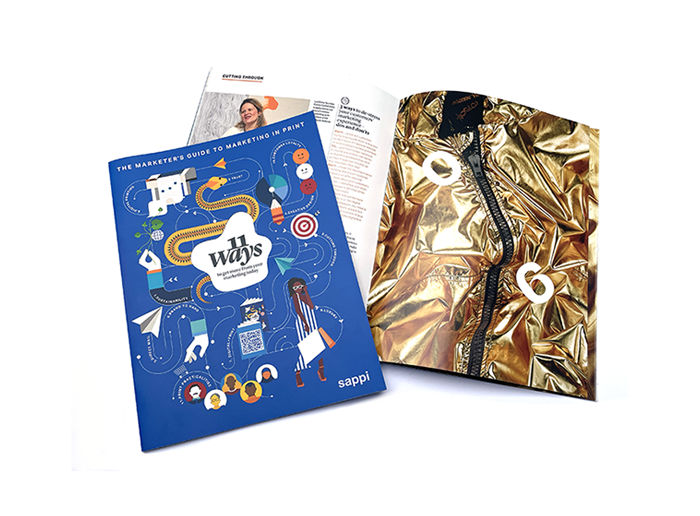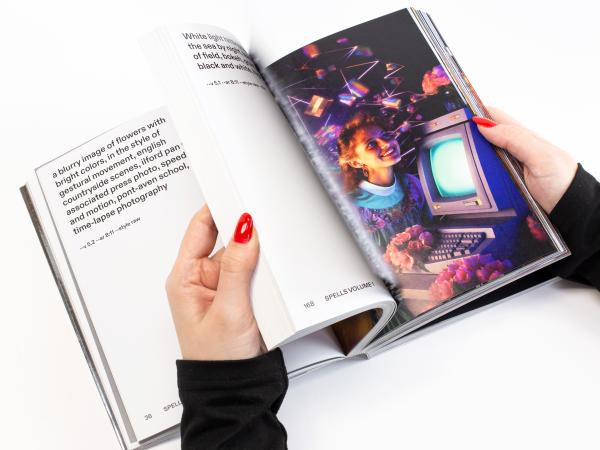Print's Precision: Cutting Through Digital Overload
Today’s consumers are being pushed to distraction – here’s how print cuts through in an age of digital overload

Entrepreneur Lizzie Evans keeps everything she needs to curate a print parcel for a prospective customer close to hand at her home studio. From a sideboard, she slips out signature wrapping papers and postcards featuring photographs of her work, pairing colours based on what she’s learnt of the recipient through online research.

“It’s almost meditative putting together the print materials. But the attention to detail that goes into it creates a connection and gives customers the feeling: ‘This is for me.’”
Thirty-eight-year-old Evans launched her business in 2009 as a London-based design store. That evolved into a design brand, and today she’s a successful surface pattern designer whose wrapping papers, stationery and homewares are sold in retail outlets across the UK. She is also a coach who mentors other designers and business owners, helping them to grow their brands, increase their revenues and maintain a good work-life balance.
Evans markets diligently to her prospective clients – stockists and future mentees – on Instagram, through her YouTube channel and website, and via a podcast in which she interviews other creative entrepreneurs. Her content marketing strategy is a whirlwind of reels, stories, posts, blogs and vlogs. Meaning that print brings a change of pace for her – and the prospects she is marketing her work to.
“Whoever’s receiving your print is looking at it just in the context of your work, rather than in a busy feed. As well as it being a quieter experience for the recipient, your work is landing in their home or their retail space. I often have a concern that I am bombarding people with information online. But you never feel that sending out a beautiful package – for someone to slowly open and enjoy going through – would be bombarding them.”
Evans’ print parcels are the culmination of a lot of careful work on social media observing the behaviour, interests and tastes of potential clients, as well as commenting on their work. Print is often the final piece in the jigsaw – meaning her work might even appear in a recipient’s Instagram story before a sale takes place. “I know if I hadn’t sent it, they wouldn’t have placed the order,” she says.
As Evans shows, there are valid marketing reasons for using print as a decisive tool that can cut through the digital hum to speak clearly to consumers – as well as give them the sense of being back in control.
Many of us struggle to manage our use of online media. A 2021 global study of 8,800 consumers carried out by consumer intelligence platform Toluna revealed that 31% believe they suffered from digital overload, with 49% regretting how much time they spend on digital devices. When it comes to online advertising, more than half of consumers actively dislike it, with 55% refusing to pay attention to digital advertising and 51% blocking online ads.
Harnessing Intentional Attention, a 2021 report by global media agency MediaCom, provides useful insights into why digital overload can make the online landscape a difficult one in which to market. Drawing on research from technology company Lumen, it details how consumer advertising attention actually decreases as the number of ads on screen increases.
Consumers, the report concludes, respond better to advertising in “non-interruptive” environments that do not contribute to cognitive overload. Used intelligently, print marketing can offer just such an environment.


Forty-one-year-old fashion designer Fanny Caillol, founder of international ecological childrenswear brand La Demo, agrees. Though the brand has a store in Paris, plus physical stockists in France, Belgium and New York, Caillol’s main marketplace is online – and she’s conscious of the digital demands placed on consumers.
“It’s hard, because all that online noise is competition, and sometimes you feel like whoever speaks the loudest is going to be heard the most. But I think about myself – if I see a sweatshirt every day for a few days, I might want it. But if I see it too much, I’m going to unfollow that brand because I can’t face seeing it anymore. Marketing online can be so pushy.”
That’s why, rather than flooding her followers’ feeds with content, Caillol creates premium print products to send to potential stockists and customers – so as to cut through and forge a direct connection.
The main La Demo print marketing tool is a 20-page, saddle-stitch brochure printed on tactile, recycled paper. Delivered in corn starch envelopes, it communicates Caillol’s brand values and shows her customers she is investing in them. “I make an object that you’re not going to want to throw away,” she says.

Copies are also available instore, and Caillol often finds that customers who take them away go on to place a second order. When it comes to follow-up marketing, she takes a personalised approach including smaller catalogues with baby products for baby orders.
For both entrepreneurs, the key to making themselves heard is offering customers a balanced content diet that includes using print as a precision channel that simultaneously offers a close-up view of the brand and allows prospects and customers to engage with it on their own terms – free from digital distractions.
A pop-up-free approach
Arthur Janzen runs Fahrwerk, a driving school in Frankenthal, near Mannheim in Germany, that he launched in 2013 at the age of 26. Today, he heads a team of five, teaching customers to drive everything from motorbikes to trucks, and is busy recruiting more instructors to meet demand.
Much of Janzen’s marketing is done through his website and via Instagram and WhatsApp – which works well for gaining awareness among the 70% of his customers who are aged between 16 and 18. But two offline, print approaches then help to drive concrete sales within that target group.
Every year, Janzen prints concert tickets for one of the town’s biggest schools – with an advert for Fahrwerk prominently on the reverse. He also produces homework books for the school, which boast a full-page advertisement at the back. So, while his customers are, as he puts it, “used to pop-ups”, these two approaches allow something different by way of noise-free exposure to his brand offer.

Janzen has also always used printed flyers, which he credits as the reason why “business is thriving”. He prints new flyers every year – showcasing new cars, new people and a new design. And always using substantial, 300g/m² stock. “I want something that is very good quality, that people like to touch and don’t want to straight away throw away,” he says.
3 ways to de-stress your customers’ marketing experience – dos and don’ts
- Don’t… bombard customers trying to persuade them to buy your product (even if it takes an average of seven contacts before purchase)
- Do… give them longer exposure to your brand on their own terms instead (the postcard they stick on their fridge over the pop-up that interrupts their day)
- Don’t… forget the key importance of thinking about your customer first (and your offer second)
- Do… think about your customer’s world, too – and where and when your message might best strike a stress-free chord
- Don’t… think that just because everyone else is on the digital marketing bandwagon, you need to throw all your efforts aboard, too
- Do… take a quiet moment of your own to think out of the digital box


